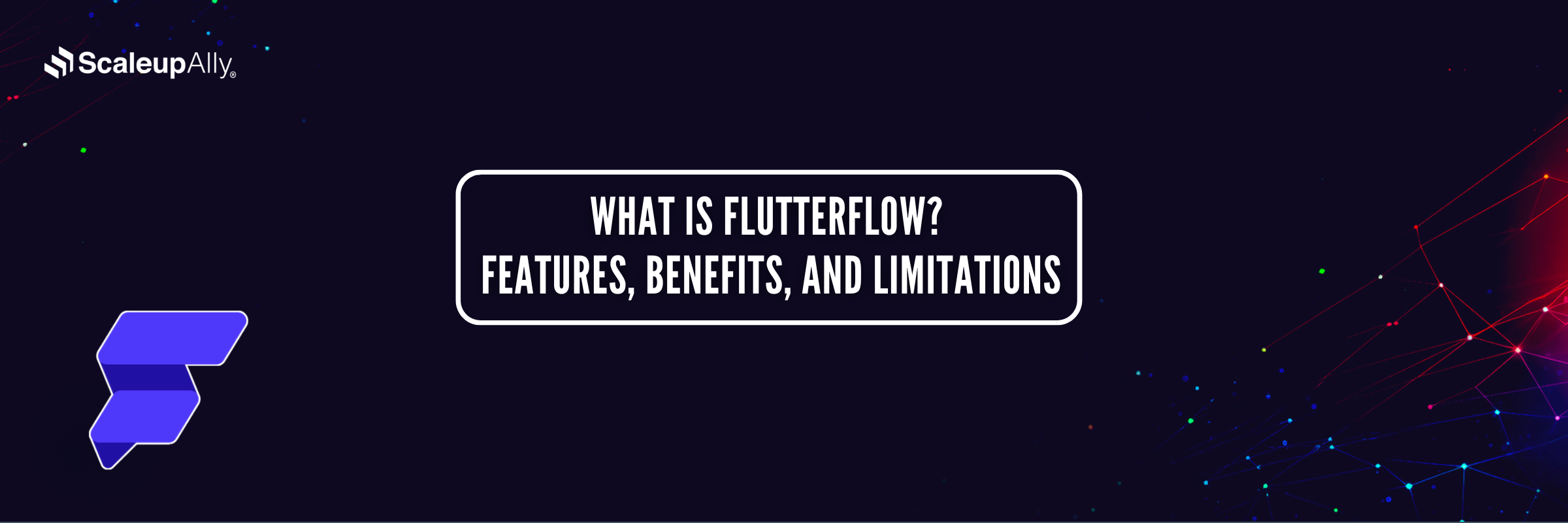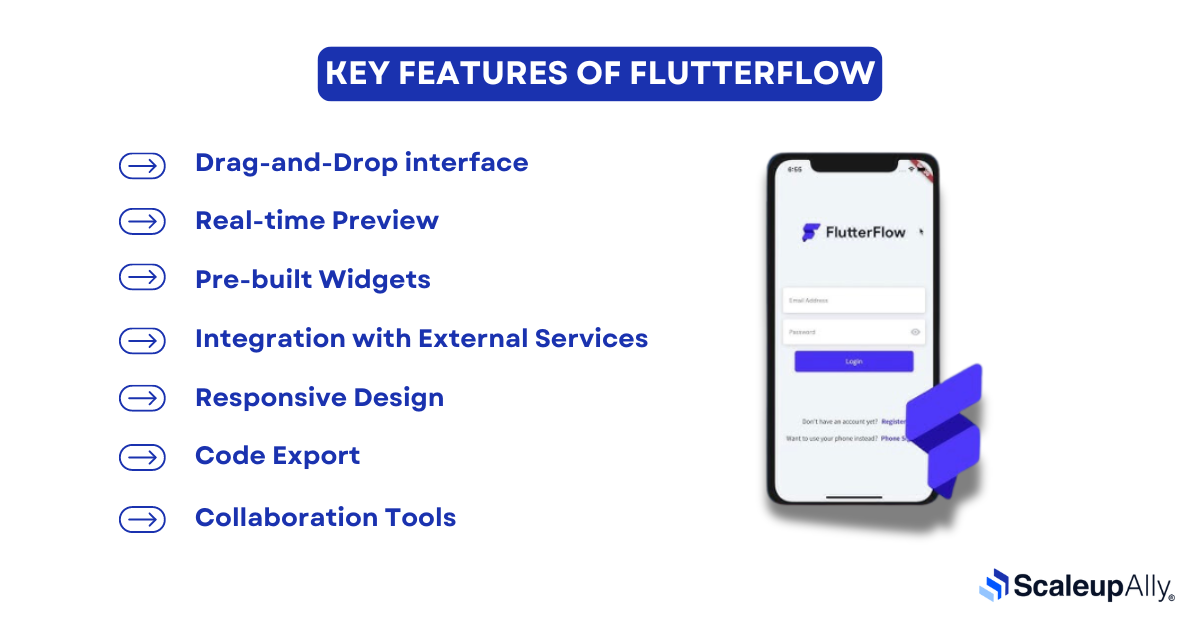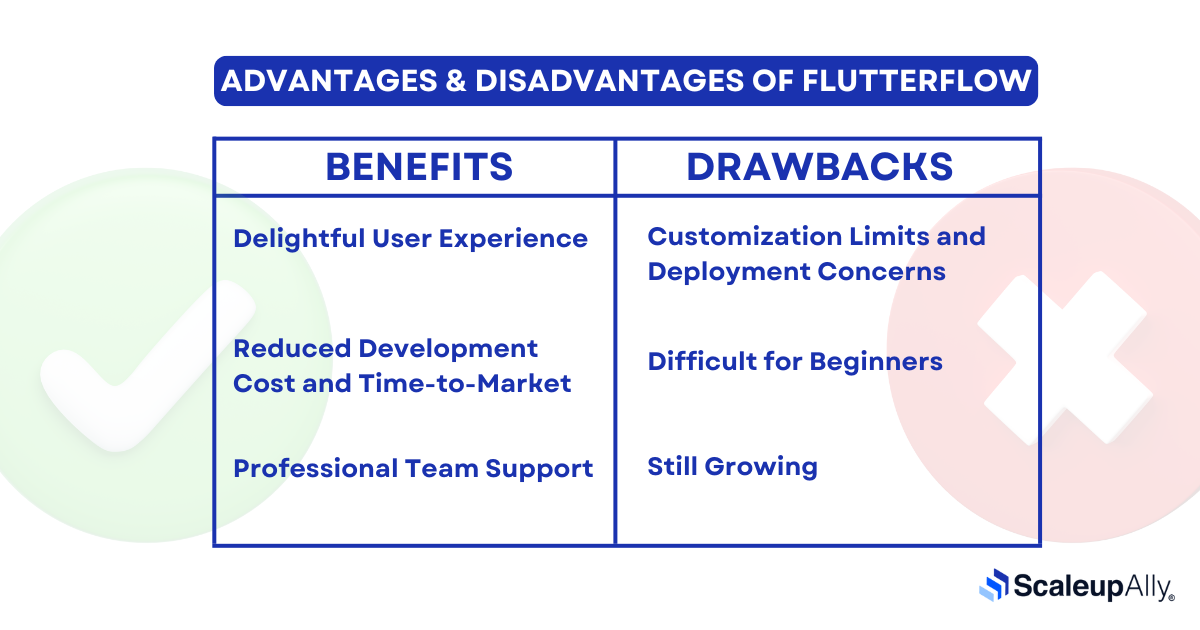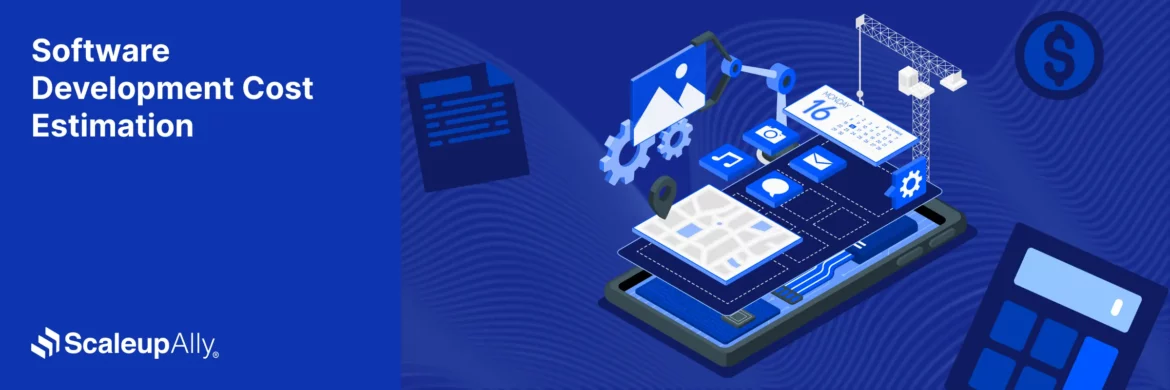
What is FlutterFlow? Features, Benefits, and Limitations
Suprabhat Sen | October 28, 2024 , 9 min read
Table Of Content
Two ex-Google engineers, Abel Mengistu and Alex Greaves noticed how slow it was to build apps and decided to reduce development time tenfold compared to traditional methods.
That idea led them to raise $25.5 million in Series A, led by GV (formerly Google Ventures) and Y Combinator.
They went ahead to hit one million users (March 2024).
That idea = FlutterFlow.
Read on to learn more about FlutterFlow and if it’s a good fit for your next app.
What is FlutterFlow?
Flutterflow is a visual app development platform that seems to be changing how apps are developed by allowing app creation through a drag-and-drop interface.
Built on top of Google’s Flutter framework, which is known for its fast performance and cross-platform capabilities, Flutterflow offers lower development costs, faster launches, and quick adjustments to market changes for businesses.
What is FlutterFlow Used For?
When building a digital product, it’s best to get it in front of your target audience as soon as possible, even if it’s just a small group, to gather feedback and improve future versions.
The issue with Native app development or cross-platform development tools like Flutter and React Native is that, while they can create high-quality apps, they take months to complete.
FlutterFlow in this case, is much faster in app development and is becoming popular as a first-choice tool for building MVPs quickly.
Key Features of FlutterFlow
Flutter Flow comes with several features that make it ideal especially for people who are not coders but do not want that challenge to limit them from bringing their ideas to life. These key features include:

1. Drag-and-Drop interface
Flutter Flow has a drag-and-drop builder that comes with over 50+ prebuilt UI components or widgets. App creators can quickly add layout elements like columns and stacks as well as app features like drop-down menus and lists, and design elements like animations, images, charts, and tab bars.
2. Real-time Preview
One of FlutterFlow’s best features is its real-time preview, which lets developers see updates instantly as they build their apps. This allows them to make quick adjustments and improvements.
3. Pre-built Widgets
FlutterFlow provides widgets, for various functions like:
- UI elements (buttons, text fields, lists).
- Navigation tools (tabs, bars, menus).
- Authentication and user management.
- Data handling and state management.
4. Integration with External Services
FlutterFlow makes it easy to integrate your app with different external services and APIs to add more features:
- Firebase: For user login, databases, and analytics.
- Payment gateways: Integrate services like Stripe and PayPal for in-app purchases.
- Social media APIs: Connect with platforms like Facebook or Twitter to engage users.
- Custom APIs: Link to any external service to expand your app’s capabilities.
5. Responsive Design
FlutterFlow allows you to build apps for iOS, Android, and the web without much extra effort. This makes it easier for businesses to reach a wider audience. It also has adaptive layout features that automatically adjust your app’s design to fit different screen sizes and orientations. This ensures your app looks good and works well on all devices, from phones to tablets.
6. Code Export
FlutterFlow lets you export your app as Flutter code, which is great for developers who want to make more advanced customizations or add the app to an existing project. This gives you the flexibility to go beyond the no-code platform if needed.
7. Collaboration Tools
FlutterFlow has team collaboration features that let multiple people work on the same project simultaneously, which is helpful for larger teams. It also includes version control to track changes, manage different app versions, and ensure everyone is using the latest version of the project.
Also Read: Pros and Cons of FlutterFlow in Production
Benefits of Using FlutterFlow

1. Delightful User Experience
FlutterFlow offers an easy-to-use interface for designing mobile and web apps quickly. It’s simple and user-friendly, allowing you to build app screens fast. With tools like Lottie and Rive, you can add interactive animations that make your app more engaging.
In today’s market, a good user experience can set your product apart, and FlutterFlow helps make your app fun and enjoyable for users, which can drive its growth.
2. Reduced Development Cost and Time-to-Market
In the FlutterFlow marketplace, you can buy templates and complete app designs to use in your project. Since it’s a visual builder, you can customize everything by dragging and dropping.
This helps you avoid overcomplicating your app early on, allowing you to test ideas quickly and make changes based on what your customers really want. Once you gain traction, you can rewrite your project in Flutter for scalability.
3. Professional Team Support
FlutterFlow facilitates team collaboration by allowing multiple people to work on an app together in real time on the same design canvas. For businesses, this is great during brainstorming sessions, as teams can quickly build clickable prototypes together.
Drawbacks of Using FlutterFlow
Hthere are some cons of FlutterFlow you need to take note of:
1. Customization Limits and Deployment Concerns
FlutterFlow is ideal for creating simple app prototypes, but it has some limitations for more complex features. The code it produces can be difficult to read and maintain. While you can add some custom code, there’s a limit to how much you can customise it.
One downside is that FlutterFlow doesn’t have a staging environment, so any changes you make go live immediately. This might be okay for smaller projects, but it can be a concern for larger businesses.
If you’re building a basic MVP app or a side app, FlutterFlow can work well. However, if you’re running a larger business or planning to grow significantly, you might want to consider using Flutter for more flexibility and control.
2. Difficult for Beginners
FlutterFlow is user-friendly if you use its pre-made templates and flows, but it’s insufficient for creating a fully functional app ready for release. If you want to build a complete app, you’ll need to start from scratch and learn how to use its advanced features, which can be time-consuming and challenging for beginners, especially compared to other low-code platforms.
FlutterFlow has a specific structure for apps that’s different from regular Flutter projects, which might frustrate developers familiar with Flutter. As a result, some developers find FlutterFlow too simple, while others think it’s too complex.
Another important point is that if you rely on FlutterFlow, you must keep up with their updates and changes, which can affect the stability of your app’s features.
3. Still Growing
FlutterFlow is still developing, so it’s not fully polished yet. Sometimes, it doesn’t work as well as it should and can’t handle bigger projects easily. You might have to find workarounds to create a fully market-ready app, and you may encounter bugs, crashes, or slower performance.
How FlutterFlow Compares to Traditional App Development?
To compare FlutterFlow with traditional app development in detail let us have a look at the table below which highlights their key differences:
| Feature | FlutterFlow | Traditional App Development |
|---|---|---|
| Ease of Learning | It is user-friendly with minimal coding | Difficult to learn and requires knowledge of programming languages and frameworks |
| Development Speed | Quick prototyping with real-time previews | Involves lengthy processes and multiple phases (planning, coding, testing) |
| Customization and Flexibility | Allows custom code injection but limited flexibility | You have full control over every aspect of the app, making it highly customizable |
| Collaboration | Real-time collaboration for teams | Often requires tools for version control and management |
| Backend Management | Integrated with Firebase support | Requires separate setup for servers, databases, and APIs |
| Cost Implications | It’s more affordable and suitable for individuals/small teams | Costs more due to the need for skilled developers and designers |
| User Experience and Design | Visual design interface simplifies layout creation | Separate design and coding processes which offer deeper customization |
| Updates and Maintenance | Easier updates through the interface | Requires ongoing coding and testing for updates |
| Deployment and Hosting | Built-in hosting options for seamless deployment | Complex deployment process requiring separate solutions |
Real-World Use Cases for FlutterFlow
1. Creating low-code MVPs
With a low-code solution like FlutterFlow, you can build apps cheaply that otherwise might be too expensive to build with traditional development methods. It helps you save time and money in the early stages, allowing you to test your ideas more often without spending too much.
Quickly creating prototypes and getting feedback from users helps you gather important data and insights, which are useful for creating a strong pitch deck and figuring out your business model. This way, you can attract investors, like Venture Capitalists, or get into startup programs for support.
2. Real-world Product Discovery
FlutterFlow encourages trying out new product ideas and features. While user research is useful, sometimes the best way to learn is by testing your product in the market. You can quickly create different versions of features to see which ones work better, gather user feedback, and make improvements.
Research shows that 80% of features in apps aren’t used very much. For early-stage startups, focus on what really matters. By using a low-code solution to create an MVP, you can learn what your customers truly need. If some of your ideas don’t work out, that’s okay. You’ll find out in just a few days, not weeks, and you’ll get important feedback to help you make your product better.
3. Building a Companion App
FlutterFlow is a great tool for creating companion apps that can help your business. You can use it to try out new ways to increase sales, attract more customers, build your brand, or improve customer support. Whether you want to make an e-commerce app, a chat app, or an educational app, FlutterFlow provides many options to help you succeed.
These are just a few ideas of what you can create with FlutterFlow. The platform keeps getting better and offers even more features to help you innovate and improve your digital products.
Conclusion
It is recommended that early-stage startups should spend 25% to 60% of their time on product and problem discovery.
From our experience, we lean more towards spending about 60% of that time. Your main goal is finding product-market fit, which involves offering a few key features that solve specific problems for a target audience. Quickly testing these ideas in the real market and gathering feedback is essential.
FlutterFlow is an excellent tool for this process, and at ScaleupAlly, our experienced developers can guide you through your app development journey. Contact us to explore your options.
Frequently Asked Questions
Q: What does FlutterFlow do?
FlutterFlow is a no-code app development platform that allows users to build mobile applications quickly and easily using a drag-and-drop interface. It integrates with Firebase for backend functionality, enabling efficient development.
Q: Is FlutterFlow better than Flutter?
FlutterFlow and Flutter serve different purposes. FlutterFlow is designed for rapid, no-code app development, while Flutter is a framework for building apps with coding flexibility. Your choice depends on your technical skills and project requirements.
Q: Is FlutterFlow free or paid?
FlutterFlow offers a free tier with limited features, allowing users to explore its capabilities. Paid plans are available for more advanced functionalities and increased project limits, providing greater flexibility and resources for developers.
References:
Related Blogs

Top 20 Emerging Technologies of 2026
Discover the top 20 emerging technologies of 2026. Explore which innovations are driving change across healthcare, finance, manufacturing, and other crucial industries.
ScaleupAlly Team
Dec 16 ,
9 min read

Software Development Timeline: Phases, Duration & Estimation Guide
Understand the software development timeline with phase durations, key factors, hidden delays, and practical methods to estimate project time.
Suprabhat Sen
Nov 29 ,
16 min read

Software Development Cost Estimation Guide: What’s Included & What Affects the Price
Explore software development cost components, major pricing factors, and practical estimation methods to plan your project accurately from start to finish.
Suprabhat Sen
Nov 29 ,
14 min read


